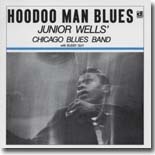|
Junior Wells
Hoodoo Man Blues
Delmark Records |

Hoodoo Man
Blues was Junior Wells’ debut LP
recording. Recorded for Delmark Records in 1965, it
was one of the first LP’s devoted to Chicago blues
and featuring a Chicago blues band. Up until that
point, nearly all original blues recordings were
done on 45s strictly for jukeboxes and radio play.
Most of the LP sales leaned heavily toward the
folk-blues sounds made popular in the early ’60s, so
believe it or not, Chicago’s brand of blues was an
unknown commodity as far as record sales went in the
mid ’60s.
Bob Koester, owner of Delmark and
Chicago’s Jazz Record Mart, really enjoyed the music, but was already
operating on a shoestring budget with the recordings he had previously
made with artists like Big Joe Williams and Sleepy John Estes. He wasn’t
sure if the record-buying public would go for the new sound since it was
so different from the folk-blues genre. He was also concerned about the
extra expense of hiring sidemen, plus the additional studio time
possibly required. However, he knew the music needed to be heard and
decided to take the plunge.
For Hoodoo Man Blues, Koester
allowed Wells to choose his own sidemen and his own material. Best of
all, he allowed Wells to go beyond the usual three-minute limit required
on 45s. This allowed the band to really focus on the music itself and
not have to worry about cutting things short. For sidemen, Wells used
familiar faces, including drummer Bill Warren, bassist Jack Myers, and
his regular guitarist at the time, Buddy Guy. Guy was supposedly under
contract with Chess Records at the time this was recorded, so Chess
agreed to allow him to play as long as he didn’t sing or use his name,
so he was forced to use a pseudonym (Friendly Chap).
The set list consisted of songs that
you probably would have heard had you attended a regular Junior Wells
gig at Theresa’s, so these were songs that the band was familiar with
and it showed. Wells exuded confidence and swagger with his
performances, such as “Snatch It Back and Hold It,” a funky James
Brown-influenced number, or the blues standard, “Good Morning
Schoolgirl.” Most of the songs appeared regularly on other Wells albums,
but the definitive versions of “Hey Lawdy Mama,” and “Early In The
Morning” can be found here.
Like most Chicago harmonica players
that got their start in the early to mid ’50s, Wells was initially
influenced by that song’s composer, John Lee “Sonny Boy I” Williamson,
but he also was influenced by others like Little Walter Jacobs, Rice
Miller (Sonny Boy II), and Junior Parker. His harmonica work was always
a model of tasteful restraint, never overplaying and always finding the
right note for the right spot.
The same can be said for Buddy Guy, at
least on this session. His guitar work is nothing short of phenomenal on
this set, with perfect fills and sharp, stinging leads. According to
Koester, Guy had problems with his amp on a couple of songs, so his
guitar was amplified through a Hammond B3 on a couple of tracks, which
gives it a shimmering, sometime eerie feel, notably on the title track.
It always seemed like teaming with Wells brought out the best in Buddy
Guy and this disc provides ample proof.
The CD reissue of Hoodoo Man Blues
includes a couple of bonus tracks, alternate takes of “Hoodoo Man
Blues,” and the smooth instrumental, “Chitlins Con Carne.” In a
reminiscence of Wells published a few years ago, Koester states that
there were about 15 minutes of additional songs (including a Wells-Guy
duet) that were accidentally erased, which is truly a shame, given the
quality of what made the cut for the disc.
Hoodoo Man Blues is still
Delmark’s biggest seller, some 40+ years after its release. It really
paved the way for subsequent recordings by Wells, Guy, and other
previously unknown or unheard Windy City bluesmen. Wells and Guy teamed
up for several more recordings, most notably the Wells release on
Vanguard, It’s My Life, Baby, a set recorded for Atlantic
featuring the duo with Eric Clapton, Dr. John, and members of the J.
Geils Band in tow, the European set Pleading The Blues (now on
Evidence), and a couple of live sets recorded at Montreaux (one on Blind
Pig, the other on Evidence). They also paired up for an acoustic set at
Guy’s club, Legends, in 1993, which proved to be their last recording
together.
However, many think their first
pairing was their best, some thinking that Hoodoo Man Blues ranks
with the best blues recordings of all.
--- Graham Clarke